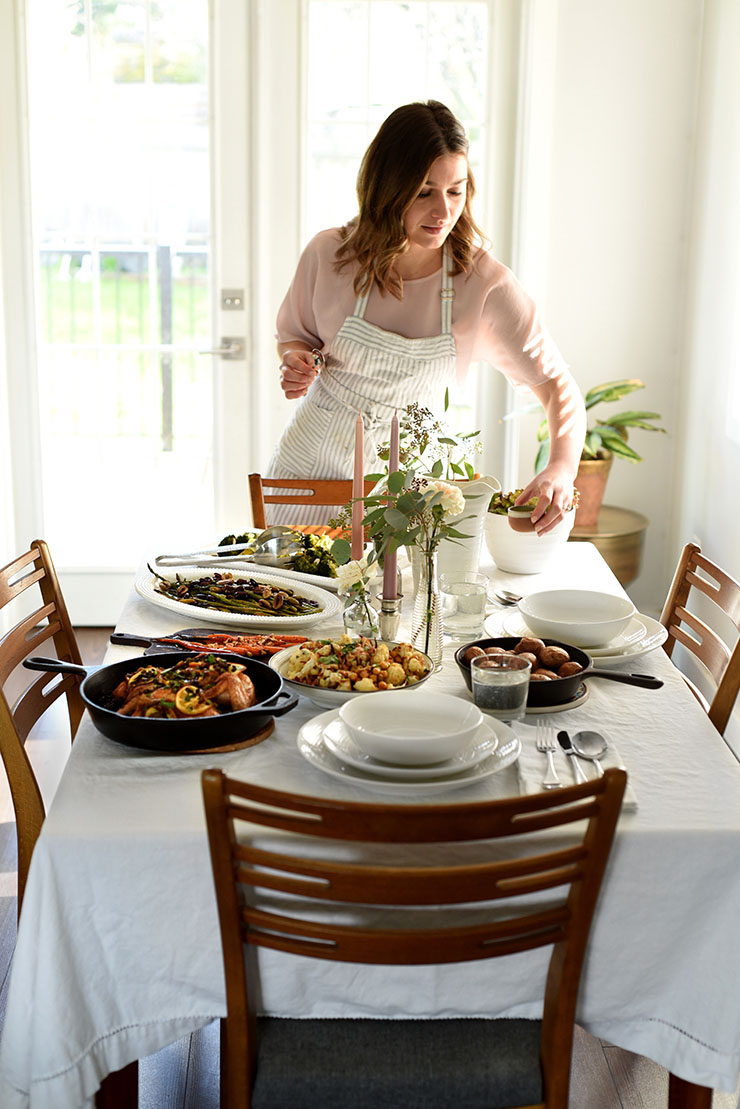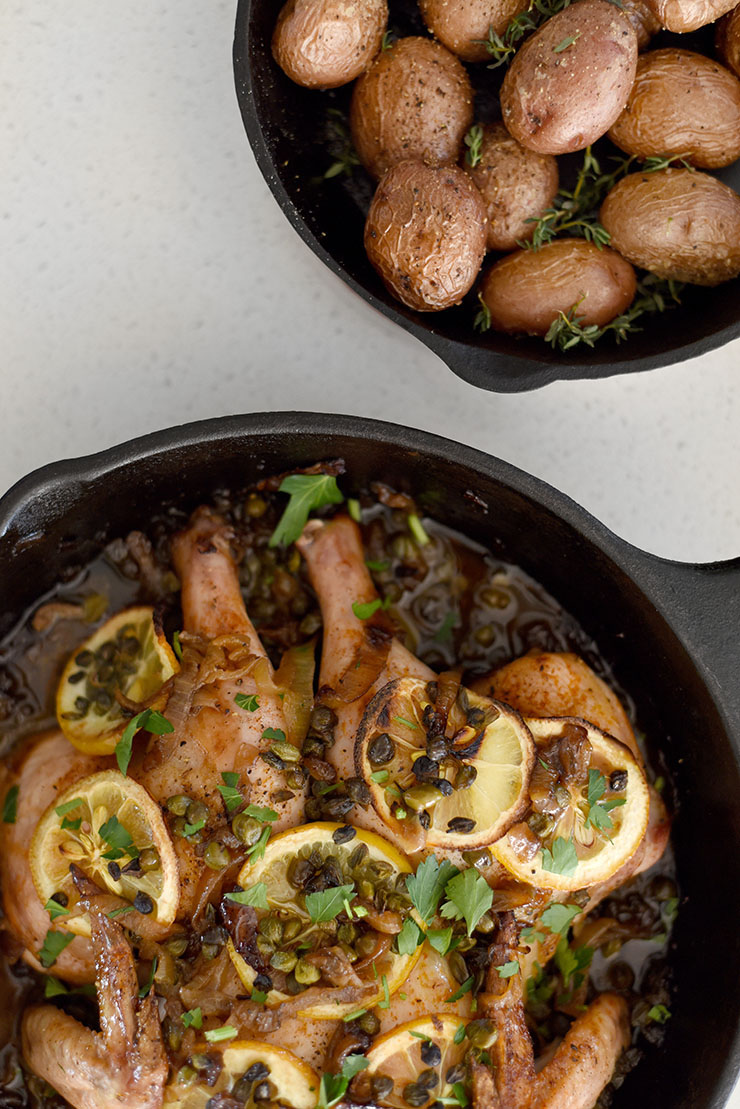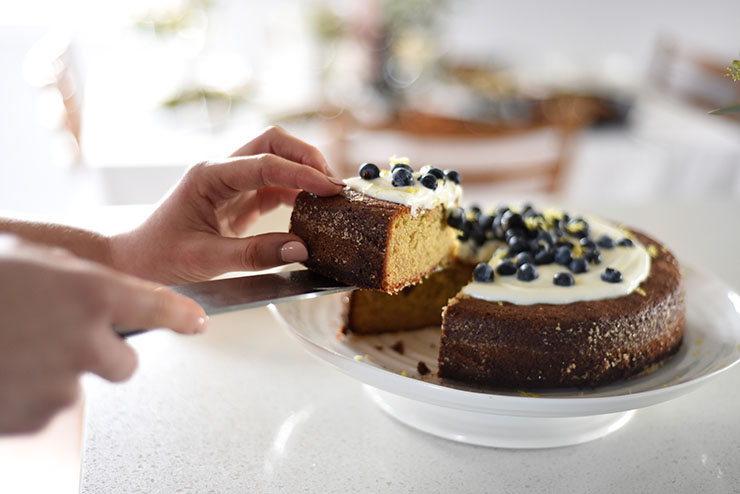
March 6, 2020 – Chef Ellie Shortt serves a family dinner.
WORDS ELLIE SHORTT X PHOTOGRAPHY DON DENTON
The warm dim of candlelight, the joyful timbre of laughter, the rich aroma of hearty fare wafting from the oven, the mirthful taste of sweet bread and lush wine, the calming comfort of familiarity, family, tradition and timelessness. For over 30 years this has been my unwavering Friday night constant.
Growing up in a Jewish household, mealtimes were more than just a necessity to pacify hunger. They were abundant, beautiful and hallowed. Many were framed by a joyous occasion or holiday. Food, and the pure pleasure of nourishment in all capacities, is a pillar in Jewish tradition, and many annual happenings, while structured by a specific purpose or celebration, culminate in some meal enjoyed with family, friends or the greater community.
But no festive feast is more consistent and more treasured than the Friday night dinner that occurs at the beginning of “Shabbat” — the Jewish sabbath. Not every Jewish household observes the sabbath, and certainly not every Jewish household practises it in the same way.
But for my family the Shabbat meal is all about plentiful merriment.
Food is my mother’s love language. She worships flavour, venerates ingredients and pours a multitude of nurturing emotions into every dish she creates. Her sabbath meals, or any other dinners she shares with family and friends, are never sparse. A fish course of a few different offerings, an assortment of salads to sample, soups to sip, a couple of meaty mains, a collection of colourful sides, and an exquisite cake or two, accompanied by a selection of seasonal fruit, are ceremoniously spread out on a crisp tablecloth one after the other throughout the night, framed by lively conversation and plentiful libations.
You may be thinking that this is all for a table of 20. While she often hosts large gatherings, the above-mentioned spread was (and still is) a regular occurrence for just our immediate family, or a few close guests. Naturally there are leftovers for days and from a young age I developed an immense appreciation for the brilliant maturing of flavour that only comes from the passing of time.
If Friday night was the pinnacle of the week, the rest of the meals were only slightly less significant. Growing up we were expected to be present — in all senses of the word — at the dinner table. Even if there weren’t half a dozen courses to work our way through over the span of a few filling hours, there always seemed to be a similar weightiness and integral importance to a simpler weeknight meal that was still prepared with so much feeling and intention. Above all, it was generously offered to us in a spirit of abundance, and we were never made to feel ashamed of healthy appetites or diminished in any way due to the sheer bliss of enjoying good food in good company.
These foundations have left a profound impression on me. As a nutritionist, cooking class instructor and co-owner of a local bistro, sharing food, and the love of food, is at the forefront of my practice and businesses. I teach people how to truly love food, and show them the ways food can love them back. I help them discover that food (and cooking) isn’t intimidating or alien. In fact, it’s integrated into the fibre of our beings, woven throughout generations and centuries. It’s the thread that ties together so many cultures and communities and is truly one of our common denominators. Food fills more than hunger in our stomachs. It fills our hearts and the deep-rooted requirement for connectivity and community. It intertwines us with nature, the seasons and organic systems.
Specific ingredients have an immense and undeniable power to provide us with essential nutrients, fuelling cognitive capacity, vitality, productivity and mental health, but mealtimes have an immense and undeniable power to provide us with essential nourishment, fuelling our souls, relationships and emotional wellbeing.
I have been in nutritional practice for nearly five years and have worked with hundreds of clients. Many of them are looking for that “superfood” or that “macro-nutrient ratio” or that “healing protocol” that’s going to somehow solve their lifelong struggles with food and eating. While I still honour and respect those requests, I simultaneously emphasize that “how you eat is more important that what you eat.” Yes, of course, if someone is choosing a highly processed, nutrient-devoid, problematic diet of “Franken-foods” and factory-made junk, it’s going to be very hard for their body to thrive and for them to achieve their wellness goals. But beyond that, when focusing on nutrient-dense whole foods from nature, the main takeaway is to eat with joy, mindfulness and appreciation, to savour the flavours, to be grateful for the ingredients, to be aware of where the ingredients come from, how they make it into our kitchens, how they’re transformed into dishes and how those dishes become our meals.
To be present with the food in front of us, and the people around us, is inextricably human, and many of us in North America feel a deepening disconnect. We feel disconnected from others, disconnected from our food system, disconnected from base experiences and from our essential selves. Technology has shrunk the world but broadened the gaps between humanity at its most primal core.
Mealtime used to be a shared experience with family, friends and community. From cultivation to cooking to consumption, it wasn’t usually done in distracted isolation as so often occurs with modern practices of pre-packaged meals and mindless ingestion, eyes glued to TV or cellphone screens. Food was made, shared and eaten with love and appreciation.
So I say let’s take back dinnertime! Let’s slowly and steadfastly begin to rebuild our relationships with others, our relationships with our own bodies, and our relationships with eating. Let’s learn the love language of food. Let’s worship flavour, venerate ingredients and pour a multitude of positive emotions into every dish we create or consume, just as my mom always did and still does today.
This practice doesn’t have to devour you. You don’t have to quit your job and tether yourself to the kitchen to build more nourishing rituals and mealtime routines. My mom was a former nurse turned interior decorator with her own business. Her days were always overflowing, and spare time was hard to find. But somehow, she magically and marvellously made time, and my father, a retina specialist with a remarkably full and demanding practice, would also miraculously create space to contribute to meals with his sweetly scientific appreciation for the culinary arts. Suffice it to say, schedules were tight but mealtimes were a priority, and they figured it out. It is possible. I know this, because I live it.
As a dual business owner with a husband who owns and operates a couple of different companies himself, abounding free time is a luxury we simply don’t have at this stage in our lives, but one thing I’ve learned in these dynamic days is that time is more fluid than we often let it be, and we make space for that which is important to us. I don’t watch a lot of TV. I switch my cellphone off in the evenings. Some nights my husband gets home at 8 or 9 pm after a long and gruelling day. But even still, he often arrives to find our table dressed in a simple tablecloth, candles lit, places set, a salad to sample, a soup to sip, a meaty main, a collection of colourful sides and a cake cooling on the counter. We sit, we laugh, we talk about our days and savour the flavours of the meal we’re enjoying together. We do this because I was taught to do this. We do this because I was taught why. This is mealtime, this is our time, and it is sacred.

March 6, 2020 – Chef Ellie Shortt’s chicken and potatoes for a family dinner.
Spatchcock Chicken with Lemon + Capers
Prep time: 10 minutes
Cook time: 30-40 minutes
Ingredients:
1 whole free-range chicken
¼ – ½ cup extra virgin olive oil
½ tsp. sea salt
½ tsp. freshly ground black pepper
1 tsp. Spanish paprika
1 lemon, sliced
½ cup capers, drained and rinsed
1 medium onion, peeled and sliced
Directions:
Preheat oven to 425ºF. Heat a medium-large cast iron pan to medium heat, coat with olive oil (about 2 Tbsp.) and sauté onions for about 5 minutes, turning throughout, until translucent and slightly golden brown (you may need to add 2 or more Tbsp. of olive oil throughout this process to avoid drying out or charring). To spatchcock the chicken, place the chicken breast-side down, with the legs towards you. Using sturdy scissors or poultry shears, cut along each side of the parson’s nose and backbone to remove it, cutting through the rib bones as you go. Open the chicken out and turn over. Flatten the breastbone with the heel of your hand so that the meat is all one thickness. Rub the skin on both sides with some olive oil, salt, pepper and paprika, and place the chicken so that it’s breast-side up on top of the cooked onions. Evenly disperse the lemon slices and capers on and around the bird. Feel free to sprinkle these toppings with some extra salt, pepper, paprika and even a little bit more olive oil. Place in the oven, and roast for about 30-40 minutes until the bird is cooked through, but still juicy and tender.
*Note: For maximum flavour, and to expedite the process at dinnertime, you can prep all of this in advance, allowing the chicken to sit seasoned and dressed in the fridge until you’re ready to roast. The spatchcock method lends itself well to an overnight marinade, and of course also provides faster roast time, making it a great quick and easy weeknight option.
Baked Asparagus with Lemon + Olives
Prep time: 5 minutes
Cook time: 15-20 minutes
Ingredients:
1 bunch of asparagus
Extra virgin olive oil (2 Tbsp. to ¼ cup)
1 Tbsp. fresh lemon zest
1 Tbsp. fresh lemon juice
¼ tsp. sea salt
¼ tsp. freshly cracked black pepper
½ cup olives, pitted and sliced in half (you can either do one kind like Kalamata or a combo of two or three)
Directions:
Preheat your oven to 425ºF and line a baking sheet with parchment paper. Trim, wash and dry the asparagus, and then toss in olive oil and lemon juice until all spears are fully coated. Arrange evenly on the baking sheet, and sprinkle with salt, pepper and lemon zest. Evenly disperse the sliced olives and cook for about 15-20 minutes until roasted and tender.
*Note: As with the chicken recipe, you can prep all of this ahead of time allowing the flavours to infuse further, and simply pop it in the oven along with your chicken when you’re ready for dinner.

March 6, 2020 – An olive oil cake, part of a family dinner from Chef Ellie Shortt.
Olive Oil Cake with Lemon + Honey
Prep time: 10 minutes
Cook time: 40 minutes
Ingredients:
1 cup extra virgin olive oil, plus extra for greasing
½ cup cane sugar, plus extra for coating
1 cup light buckwheat flour
1 cup almond flour
2 tsp. baking powder
½ tsp. baking soda
½ tsp. sea salt
3 large free-range eggs, yolks and whites divided
Zest and juice of one lemon
3 tsp. vanilla
¼ cup honey
Directions:
Preheat oven to 350ºF. Brush a 9-inch springform pan with olive oil and line the bottom with parchment paper. One option is to sprinkle the edges of the pan with some extra cane sugar (it adds a nice sweet crunch to the crust of the cake). Whisk both flours, baking powder, baking soda and sea salt in a medium bowl and set aside. Combine the lemon zest, lemon juice, vanilla and honey in a small bowl and set aside. Using an electric mixer, beat the sugar and olive oil for 1 minute. Beat in yolks, then honey, lemon and vanilla mixture until peaks form. Slowly stir in the flour mixture and, once combined, set aside. Using clean, dry beaters, beat egg whites in another medium bowl (or the same one, but washed and dried) until soft peaks form. Fold egg whites into batter just to blend in 2 additions. Transfer to prepared pan, smooth top, and bake for 35-45 minutes (you can check by inserting a clean knife into the centre and checking if it comes out clean). Remove from oven, set aside to cool for about 15 minutes before running a dull knife along the edges and removing from the springform pan. Enjoy slightly warm, or allow to fully cool, adding toppings of choice.
*Gluten-free and refined-sugar free, this cake is shown with Greek yogurt whipped with honey and fresh blueberries, but leave off the yogurt for a fully dairy-free dessert as well.
*Note: this cake keeps for about four days if sealed in either an airtight container or wrapped thoroughly. The cake also freezes well, but allow to cool fully, and store in an airtight Ziploc bag before placing in freezer.

 History. Culture. Cuisine. Dresden is a delight
History. Culture. Cuisine. Dresden is a delight